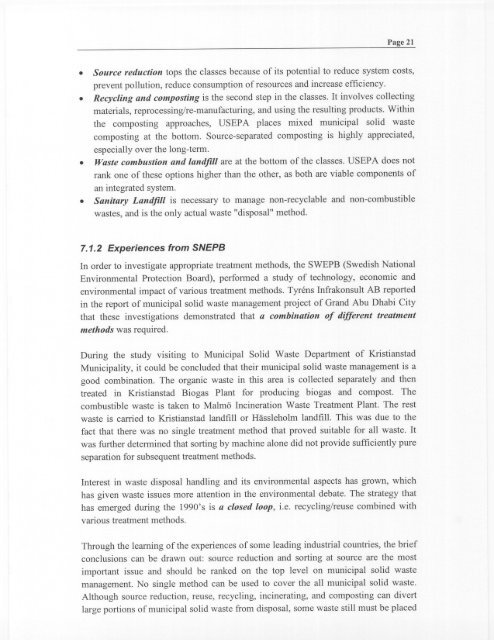a case study of municipal solid waste management in the ... - lumes
a case study of municipal solid waste management in the ... - lumes
a case study of municipal solid waste management in the ... - lumes
Create successful ePaper yourself
Turn your PDF publications into a flip-book with our unique Google optimized e-Paper software.
Page 21....Source reduction tops <strong>the</strong> classes because <strong>of</strong> its potential to reduce system costs,prevent pollution, reduce consumption <strong>of</strong>resources and <strong>in</strong>crease efficiency.Recycl<strong>in</strong>g and compost<strong>in</strong>g is <strong>the</strong> second step <strong>in</strong> <strong>the</strong> classes. It <strong>in</strong>volves collect<strong>in</strong>gmaterials, reprocess<strong>in</strong>g/re-manufactur<strong>in</strong>g, and us<strong>in</strong>g <strong>the</strong> result<strong>in</strong>g products. With<strong>in</strong><strong>the</strong> compost<strong>in</strong>g approaches, USEP A places mixed <strong>municipal</strong> <strong>solid</strong> <strong>waste</strong>compost<strong>in</strong>g at <strong>the</strong> bottom. Source-separated compost<strong>in</strong>g is highly appreciated,especially over <strong>the</strong> long-term.Waste combustion and landfill are at <strong>the</strong> bottom <strong>of</strong> <strong>the</strong> classes. USEP A does notrank Olle <strong>of</strong> <strong>the</strong>se options higher than <strong>the</strong> o<strong>the</strong>r, as both are viable components <strong>of</strong>an <strong>in</strong>tegrated system.Sanitary Landfill is necessary to manage non-recyclable and non-combustible<strong>waste</strong>s, and is <strong>the</strong> only actual <strong>waste</strong> "disposal" method.7.1.2 Experiences from SNEPBIn order to <strong>in</strong>vestigate appropriate treatment methods, <strong>the</strong> SWEPB (Swedish NationalEnvironmental Protection Board), performed a <strong>study</strong> <strong>of</strong> technology, economic andenvironmental impact <strong>of</strong> various treatment methods. Tyrens Infrakonsult AB reported<strong>in</strong> <strong>the</strong> report <strong>of</strong> <strong>municipal</strong> <strong>solid</strong> <strong>waste</strong> <strong>management</strong> project <strong>of</strong> Grand Abu Dhabi Citythat <strong>the</strong>se <strong>in</strong>vestigations demonstrated that a comb<strong>in</strong>ation <strong>of</strong> different treatmentmethods was required.Dur<strong>in</strong>g <strong>the</strong> <strong>study</strong> visit<strong>in</strong>g to Municipal Solid Waste Department <strong>of</strong> KristianstadMunicipality, it could be concluded that <strong>the</strong>ir <strong>municipal</strong> <strong>solid</strong> <strong>waste</strong> <strong>management</strong> is agood comb<strong>in</strong>ation. The organic <strong>waste</strong> <strong>in</strong> this area is collected separatelyand <strong>the</strong>ntreated <strong>in</strong> Kristianstad Biogas Plant for produc<strong>in</strong>g biogas and compost. Thecombustible was te is taken to Malmö Inc<strong>in</strong>eration Waste Treatment Plant. The rest<strong>waste</strong> is carried to Kristianstad landfill or Hässleholm landfill. This was due to <strong>the</strong>fact that <strong>the</strong>re was no s<strong>in</strong>gle treatment method that prov ed suitable for all <strong>waste</strong>. Itwas fur<strong>the</strong>r determ<strong>in</strong>ed that sort<strong>in</strong>g by mach<strong>in</strong>e alone did not provide sufficiently pureseparation for subsequent treatment methods.Interest <strong>in</strong> <strong>waste</strong> disposal handl<strong>in</strong>g and its environmental aspects has grown, whichhas given <strong>waste</strong> issues more attention <strong>in</strong> <strong>the</strong> environmental debate. The strategy thathas emerged dur<strong>in</strong>g <strong>the</strong> 1990's is a closed loop, i.e. recycl<strong>in</strong>g/reuse comb<strong>in</strong>ed withvarious treatment methods.Through <strong>the</strong> leam<strong>in</strong>g <strong>of</strong> <strong>the</strong> experiences <strong>of</strong> same lead<strong>in</strong>g <strong>in</strong>dustri al countries, <strong>the</strong> briefconclusions can be drawn out: source reduction and sort<strong>in</strong>g at source are <strong>the</strong> mostimportant issue and should be ranked on <strong>the</strong> top levelon <strong>municipal</strong> <strong>solid</strong> <strong>waste</strong><strong>management</strong>. No s<strong>in</strong>gle method can be used to cover <strong>the</strong> all <strong>municipal</strong> <strong>solid</strong> <strong>waste</strong>.Although source reduction, reuse, recycl<strong>in</strong>g, <strong>in</strong>c<strong>in</strong>erat<strong>in</strong>g, and compost<strong>in</strong>g can divertlarge portions <strong>of</strong> <strong>municipal</strong> <strong>solid</strong> <strong>waste</strong> from disposal, same <strong>waste</strong> still must be placed
















